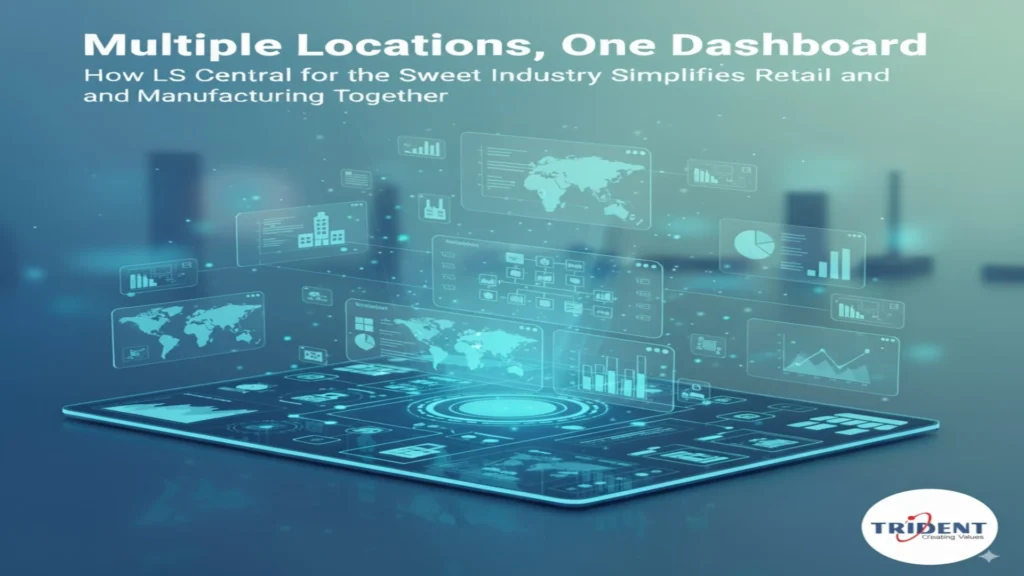Multiple Locations, One Dashboard: How LS Central for the Sweet Industry Simplifies Retail and Manufacturing Together
Introduction: Why Sweet Brands Struggle with Multi-Location Operations Running a growing sweets business across many outlets and one or more production sites can feel like juggling hot jalebis—drop one, and everything gets sticky. Stores chase stock, factories chase schedules, and finance chases the truth. The bigger the footprint, the harder it gets to see what’s really happening in real time. That’s exactly where LS Central for Sweet Industry steps in, providing a unified platform that connects retail and manufacturing, simplifies complexity, and empowers sweet brands to scale without losing control. The Split Between Storefronts and Factories Retail runs on speed; production works in batches. When the systems behind them don’t talk to each other, managers find themselves playing catch-up—spending hours reconciling sales data with production orders. By the time decisions are made, the opportunity has often passed. And when that happens, you lose freshness, cash, and even customer trust. Data Silos That Slow Decisions Does this sound familiar? Pricing is stuck in spreadsheets, production is managed in a separate app, and customer loyalty is tracked somewhere else. Each update takes manual work, leading to errors, conflicting data, and outdated reports. These silos create bottlenecks that slow everything down, leaving business leaders buried under data that’s no longer relevant by the time they see it. What is LS Central for the Sweet Industry? LS Central for the Sweet Industry is a game-changer. It’s a platform that brings retail, manufacturing, and finance into one seamless system. Whether you’re selling sweets or running a bakery, this all-in-one solution gives you full control over your operations—from product creation to customer checkout—without ever needing to switch between systems. Built on Microsoft Dynamics 365 Business Central Because LS Central is built on the Microsoft Dynamics 365 platform, it comes with robust ERP capabilities for everything from financial management and inventory to manufacturing. With fewer integrations to maintain, you can focus on growing your business without worrying about constantly managing updates or connections. Who Is It For? LS Central works perfectly for businesses in the sweet industry, whether you run a boutique chocolate shop, a sweets and snacks chain, artisan bakeries, or ice cream kiosks in malls. Whatever your process—whether it’s mixing, baking, or serving—LS Central helps connect the dots without disrupting your workflow. One Unified Dashboard Across All Locations Imagine being able to view everything at a glance: sales trends, stock-outs, batch yields, and even waste, all sorted by store, plant, or region. With LS Central, this is your new “single version of the truth.” It’s a dashboard that helps you take control, ensuring consistency and accuracy, no matter where you are. Executive Cockpit with Live KPIs Stay on top of key performance indicators like today’s sales vs. forecast, channel-wise performance, top-selling products, and margin leakages. If something’s off—like an unexpected dip in a bestseller—alerts will help you quickly identify the cause. Store, Factory, and Warehouse Views in One Place You can zoom out to see a national heatmap or zoom in on a specific store’s hourly sales. If you’re interested in factory performance, you can drill down into batch performance. The beauty of LS Central is that the same data backbone powers all of these views, keeping operations, merchandising, and finance aligned. Mobile Monitoring When You’re on the Move Running between locations? LS Central’s mobile dashboards let you approve promotions, release production orders, and even check cold-room temperatures—all from your phone. No need to be physically present to stay in control. Multi-Location Retail, Simplified The more stores you open, the more complex retail management becomes. LS Central makes it easy by acting as a central hub for item management, pricing, promotions, and POS operations. Set your rules once and deploy them across every store with minimal hassle. Centralized Item, Pricing, and Promotions Create products once, roll them out to all locations, and set up promotions with start and end dates. Want to test combos or seasonal offers? It’s easy to do with just a few clicks, and those changes will be reflected instantly across the entire network. Fast, Reliable POS with Offline Resilience Even if the internet goes down, your POS will still process transactions and sync once the connection is restored. Cashiers will have intuitive screens, making the checkout process quick, whether it’s barcodes, QR codes, UPI, or gift cards. Loyalty, Gifting, and Referrals That Drive Repeat Buys Use LS Central’s loyalty features to create personalized offers based on customers’ purchase history. E-gift cards and festive hampers can be scheduled for later use, and simple upsell nudges like “add a pack of assorted mithai for 10% off” can help boost average order values. Omnichannel Integration: eCommerce, Marketplaces, and Aggregators Sync all inventory, pricing, and orders between your website, delivery apps, and marketplaces. When a store fulfills an online order, LS Central updates the stock in real-time, ensuring inventory and financials are always in sync. Manufacturing That Feels Native (Not Bolted On) Many retail systems treat manufacturing like an afterthought. LS Central, however, fully integrates production into the system. For the sweet industry, where precision and freshness matter, this integration is essential. Recipe/BOM Management and Batch Scaling Define recipes with ingredients, process steps, and yields. When you need to scale batches for promotions or bulk orders, LS Central handles it automatically—keeping everything from sugar-free options to seasonal flavors organized without hassle. Production Planning, Sequencing, and Capacity Plan production by line, shift, or resource. Sequence batches to minimize changeovers (e.g., making nut-free items before those with nuts), and use capacity views to identify bottlenecks so you can rebalance production quickly. Allergen, Nutrition, and Shelf-Life Tracking Maintain allergen and nutrition information, plus track shelf life at the recipe level. This makes label compliance easy and keeps your customers safe, especially when dealing with gift boxes or mixed assortments. Lot/Expiry Control and Recall Readiness Each batch and finished goods lot is traceable from raw materials to retail. If you ever need to recall a product, LS Central allows you to identify and isolate affected lots, notifying stores










